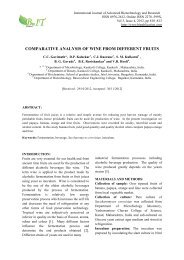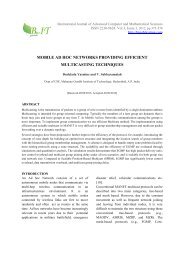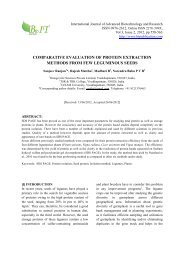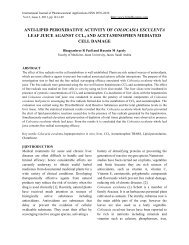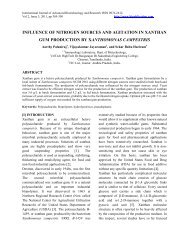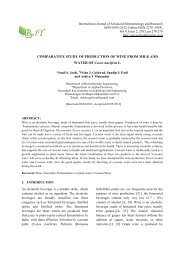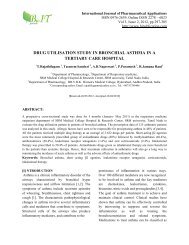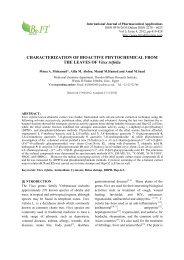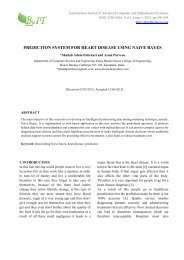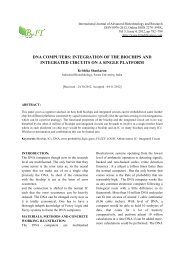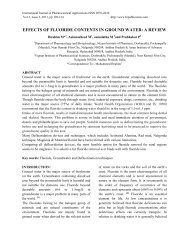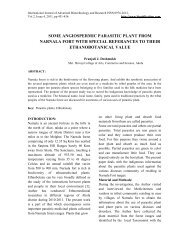antibacterial targets in pseudomonas aeruginosa - ResearchGate
antibacterial targets in pseudomonas aeruginosa - ResearchGate
antibacterial targets in pseudomonas aeruginosa - ResearchGate
Create successful ePaper yourself
Turn your PDF publications into a flip-book with our unique Google optimized e-Paper software.
ANTIBACTERIAL TARGETS IN PSEUDOMONAS AERUGINOSA<br />
Glucose-6-phosphate<br />
AlgC<br />
Glucose-1-phosphate<br />
RmlA<br />
dTDP-D-glucose<br />
RmlB<br />
dTDP-6-deoxy-D-4-hexulose<br />
RmlC<br />
fattyacid de novo synthesis<br />
RhlG<br />
3-ketoacyl-ACP<br />
dTDP-6-deoxy-L-lyxo-4-hexulose 3-hydroxyacyl-ACP<br />
RmlD<br />
RhlA<br />
dTDP-L-rhamnose + 3-(3-hydroxyalkanoyloxy)alkanoates<br />
RhlB<br />
mono-rhamnolipids<br />
RhlC<br />
di-rhamnolipids<br />
Figur 1: Rhamnolipids Biosynthetic Pathway<br />
Esterase EstA<br />
Esterase EstA is an autotransporter prote<strong>in</strong><br />
located <strong>in</strong> the outer membrane. Autotransporters<br />
predom<strong>in</strong>antly show physiological functions<br />
related to the virulence of the correspond<strong>in</strong>g<br />
organisms. EstA was found to be required for<br />
full virulence <strong>in</strong> a rat model of chronic<br />
respiratory <strong>in</strong>fection. Inactivation of the estA<br />
gene not only resulted <strong>in</strong> rhamnolipid deficiency<br />
but also <strong>in</strong>fluenced other virulence-related<br />
functions like cellular motility, i.e., swimm<strong>in</strong>g,<br />
twitch<strong>in</strong>g motility, and swarm<strong>in</strong>g [1, 60]. So this<br />
prote<strong>in</strong> can be a good drug target.<br />
Polyphosphate K<strong>in</strong>ase<br />
PPK is responsible for the synthesis of<br />
polyphosphate from ATP. It is required for<br />
motility and is essential for quorum sens<strong>in</strong>g and<br />
virulence. Also <strong>in</strong>hibition of PPK prevents the<br />
formation of the biofilm. PPK is highly<br />
conserved <strong>in</strong> prokaryotes and is absent <strong>in</strong><br />
eukaryotes. This all suggests that PPK is a<br />
therapeutic target to treat P. aerug<strong>in</strong>osa<br />
<strong>in</strong>fections. Also s<strong>in</strong>ce PPK is <strong>in</strong>volved <strong>in</strong> the<br />
cellular metabolism rather than <strong>in</strong> an essential<br />
function, the chances to provoke resistance are<br />
less [45, 49].<br />
REFERENCES<br />
1. Al-Tahhan, R.A., Sandr<strong>in</strong>, T.R., Bodour, A.A.,<br />
Maier, R.M. (2000). Rhamnolipid-<strong>in</strong>duced removal<br />
of lipopolysaccharide from Pseudomonas<br />
aerug<strong>in</strong>osa: effect on cell surface properties and<br />
<strong>in</strong>teraction with hydrophobic substrates. Applied and<br />
Environtal Microbiology, 66:3262–3268.<br />
2. Aparna., Madhu, S., Sarita, Y. (2008). Biofilms:<br />
microbes and disease. The Brazilian Journal of<br />
Infectious Diseases, 12:526-530.<br />
3. Baltch, A. L., Obrig, T.G., Snith, R.P., Hammer,<br />
M.C., Conroy, J.V. (1987). Production of cytotox<strong>in</strong><br />
by cl<strong>in</strong>ical stra<strong>in</strong>s of Pseudomonas aerug<strong>in</strong>osa.<br />
Canadian Journal of Microbiology, 33: 104-111.<br />
4. Baltch, A.L., Hammer, M.C., Smith, R.P., et al.<br />
(1985). Effects of Pseudomonas aerug<strong>in</strong>osa cytotox<strong>in</strong><br />
on human serum and granulocytes and their<br />
microbicidal, phagocytic, and chemotactic functions.<br />
Infectious Immunology, 48:498-506.<br />
5. Bentzmann, S.D., Roger, P., Puchelle, E. (1996).<br />
Pseudomonas aerug<strong>in</strong>osa adherence to remodell<strong>in</strong>g<br />
respiratory epithelium. European Respiratory<br />
Journal 9: 2145–2150.<br />
6. Bleau, C., Beaumont, M., Sanschagr<strong>in</strong>, F.,<br />
Voyer, N., Levesque, R.C. (2007). Parallel solid<br />
synthesis of <strong>in</strong>hibitors of the essential cell division<br />
FtsZ enzyme as a new potential class of <strong>antibacterial</strong>.<br />
Bioorganic & Medic<strong>in</strong>al Chemistry, 15:1330–1340.<br />
7. Bleau, C.P., Sanschagr<strong>in</strong>, F., Levesque, R.C.<br />
(2004). Identification of Pseudomonas aerug<strong>in</strong>osa<br />
FtsZ peptide <strong>in</strong>hibitors as a tool for development of<br />
novel antimicrobials. Journal of Antimicrobial<br />
Chemotherapy, 40:235-238.<br />
8. Burke, V., Rob<strong>in</strong>son, J. O., Richardson, C. J. L.<br />
& Bundell, C. S. (1991). Longitud<strong>in</strong>al studies of<br />
virulence factors of Pseudomonas aerug<strong>in</strong>osa <strong>in</strong><br />
cystic fibrosis. Pathology 23: 145-148.<br />
9. Cegelski, L., Marshall, G.R., Eldridge, G.R.,<br />
Hultgren, S.J. (2008). The biology and future<br />
prospects of antivirulence therapy. Microbiology,<br />
6:17-27.<br />
10. Celik, I., Cihangiroglu, M., Yilmaz, T., Kohle,<br />
U., Akbulut, A. (2006). The prevalence of<br />
bacteraemia-related ret<strong>in</strong>al lesions <strong>in</strong> seriously ill<br />
patients. Journal of <strong>in</strong>fection, 52:97–100.<br />
11. Church, D., Elsayed, S., Reid, O., W<strong>in</strong>ston, B.,<br />
L<strong>in</strong>dsay, R. (2006). Burn wound <strong>in</strong>fections. Cl<strong>in</strong>ical<br />
Microbiology Reviews, 19:403-434.<br />
12. Clements, J.M., Coignard, F., Johnson, I.,<br />
Chandler, S., Palan, S., Waller, A., Wijkmans, J.,<br />
Hunter, M.G. (2002). Antibacterial activities and<br />
characterization of novel <strong>in</strong>hibitors of LpxC.<br />
Antimicrobial Agents and Chemotherapy, 46: 1793–<br />
1799.<br />
13. Cloete, T.E., Jacobs L. (2001). Surfactants and<br />
the attachment of Pseudomonas aerug<strong>in</strong>osa to 3CR12<br />
sta<strong>in</strong>less steel and glass. Water SA 27: 21-26.<br />
Shanooba M. Palamthodi, et al. 162



